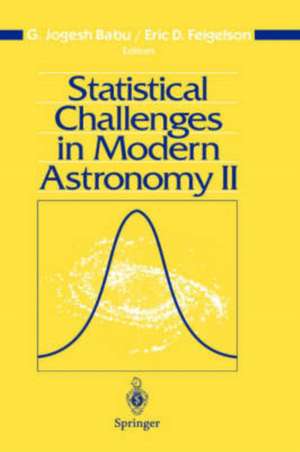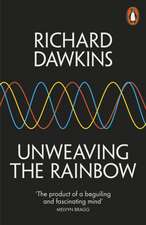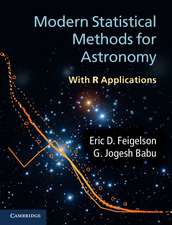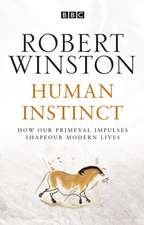Statistical Challenges in Modern Astronomy II
Editat de G. Jogesh Babu, Eric D. Feigelsonen Limba Engleză Hardback – 26 iun 1997
| Toate formatele și edițiile | Preț | Express |
|---|---|---|
| Paperback (1) | 953.65 lei 6-8 săpt. | |
| Springer – 4 noi 2012 | 953.65 lei 6-8 săpt. | |
| Hardback (1) | 959.98 lei 6-8 săpt. | |
| Springer – 26 iun 1997 | 959.98 lei 6-8 săpt. |
Preț: 959.98 lei
Preț vechi: 1170.71 lei
-18% Nou
Puncte Express: 1440
Preț estimativ în valută:
183.70€ • 192.67$ • 152.92£
183.70€ • 192.67$ • 152.92£
Carte tipărită la comandă
Livrare economică 01-15 aprilie
Preluare comenzi: 021 569.72.76
Specificații
ISBN-13: 9780387982038
ISBN-10: 0387982035
Pagini: 469
Ilustrații: XVIII, 469 p.
Dimensiuni: 155 x 235 x 27 mm
Greutate: 0.86 kg
Ediția:1997
Editura: Springer
Colecția Springer
Locul publicării:New York, NY, United States
ISBN-10: 0387982035
Pagini: 469
Ilustrații: XVIII, 469 p.
Dimensiuni: 155 x 235 x 27 mm
Greutate: 0.86 kg
Ediția:1997
Editura: Springer
Colecția Springer
Locul publicării:New York, NY, United States
Public țintă
ResearchDescriere
Modern astronomical research faces a vast range of statistical issues which have spawned a revival in methodological activity among astronomers. The Statistical Challenges in Modern Astronomy II conference, held in June 1996 at the Pennsylvania State University five years after the first conference, brought astronomers and statisticians together to discuss methodological issues of common interest. Time series analysis, image analysis, Bayesian methods, Poisson processes, nonlinear regression, maximum likelihood, multivariate classification, and wavelet and multiscale analyses were important themes. Astronomers frequently encounter troublesome situations such as heteroscedastic weighting of data, unevenly spaced time series, and selection effects leading to censoring and truncation. Many problems were introduced at the conference in the context of large-scale astronomical projects inlcuding LIGO, AXAF, XTE, Hipparcos, and digitized sky surveys.This volume will be of interest to researchers and advanced students in both fields-astronomers who seek exposure to recent developments in statistics, and statisticians interested in confronting new problems. It is edited by two faculty members of the Pennsylvania State University who have a long-standing cross-disciplinary collaboration and jointly authored the recent introductory monograph "Astrostatics." G.J. Babu is Professor of Statistics, Fellow of the Institute of Mathematical Statistics, and Associate Editor of the Journal of Statistical Planning & Inference and the Journal of Nonparametric Statistics. Eric D. Feigelson is Professor of Astronomoy and Astrophysics.
Cuprins
1 Pre and Post Least Squares: The Emergence of Robust Estimation.- 2 Some Recent Developments in Bayesian Analysis, with Astronomical Illustrations.- 3 Bayesian Analysis of Lunar Laser Ranging Data.- 4 Modern Statistical Methods for Cosmological Testing.- 5 Comparing Censoring and Random Truncation via Nonparametric Estimation of a Distribution Function.- 6 Astronomical (Heteroscedastic) Measurement Errors: Statistical Issues and Problems.- 7 New Problems and Approaches Related to Large Databases in Astronomy.- 8 Object Classification in Astronomical Images.- 9 Recent Advances in Large-scale Structure Statistics.- 10 Wavelet Transform and Multiscale Vision Models.- 11 Statistical Software, Siftware and Astronomy.- 12 Statistical Issues in the MACHO Project.- 13 LIGO: Identifying Gravitational Waves.- 14 AXAF Data Analysis Challenges.- 15 Statistical Aspects of the Hipparcos Photometric Data.- 16 Application of Wavelet Analysis to the Study of Time-dependent Spectra.- 17 Nonparametric Methods for Time Series and Dynamical Systems.- 18 Quantifying Rapid Variability in Accreting Compact Objects.- 19 Wavelet and Other Multi-resolution Methods for Time Series Analysis.- 20 An Overview of “SCMA II”.- 21 Late-Night Thoughts of a Classical Astronomer.- 22 Algorithms for the Detection of Monochromatic and Stochastic Gravitational Waves.- 23 Statistical Tests for Changing Periods in Sparsely Sampled Data.- 24 Analyzing X-ray Variability by Linear State Space Models.- 25 The Time Interferometer: Spectral Analysis of the Gapped Time Series from the Stand Point of Interferometry.- 26 Structures in Random Fields.- 27 The New ?-CFAR Detector For Astronomical Image Processing.- 28 Bayesian Image Reconstruction with Noise Suppression.- 29 Astronomical Images Restoration by the Multiscale Maximum Entropy Method.- 30 Nested Test for Point Sources.- 31 Segmenting Chromospheric Images with Markov Random Fields.- 32 Analysis of Hipparcos Data in the Orthonormal Wavelet Representation.- 33 Statistical Properties of Wavelet Transforms Applied to X-Ray Source Detection.- 34 Wavelet Based X-Ray Spatial Analysis: Statistical Issues.- 35 Wavelet and Multifractal Analyses of Spatial and Temporal Solar Activity Variations.- 36 Wavelets in Unevenly Spaced Data: OJ 287 light curve.- 37 Wavelet Based Analysis of Cosmic Gamma-Ray Burst Time Series.- 38 Smoothed Nonparametic Density Estimation for Censored or Truncated Samples.- 39 Luminosity and Kinematics: A Maximum Likelihood Algorithm for Exploitation of the Hipparcos Data.- 40 Assessing Statistical Accuracy to the Orbital Elements of Visual Double Stars by Means of Bootstrap.- 41 A Poisson Parable: Bias in Linear Least Squares Estimation.- 42 Neural Network Classification of Stellar Spectra.- 43 Multidimensional Index for Highly Clustered Data with Large Density Contrasts.- 44 Quantitative Morphology of Moderate Redshift Peculiar Galaxies.- 45 Bayesian Inference on Mixed Luminosity Functions.- 46 Stochastic Solutions for the Hipparcos Astrometric Data Merging.- 47 Identification of Nonlinear Factors in Cosmic Gamma-ray Bursts.- 48 Statistical Challenges in Asteroid Dynamics.- 49 Brief Annotated Bibliography on Point Processes.- 50 Testing the Hubble Law from Magnitude-Redshift Data of Field Galaxies: The Effect of the Shape of the Luminosity Function.















